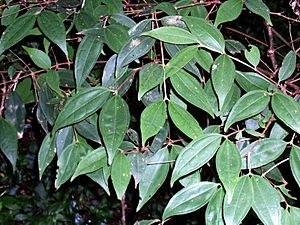Scrub stringybark facts for kids
Quick facts for kids Scrub stringybark |
|
|---|---|
 |
|
| Rhodamnia rubescens at Elvina Bay, Australia. | |
| Conservation status | |
| Scientific classification | |
| Genus: |
Rhodamnia
|
| Species: |
rubescens
|
| Synonyms | |
Rhodamnia rubescens, also known as the scrub stringybark, brush turpentine, or brown malletwood, is a type of evergreen rainforest tree. It belongs to the myrtle family, Myrtaceae. This tree is native to Eastern Australia.
You can spot this tree by its stringy bark and leaves with three clear veins. It grows in many different rainforests. These areas stretch from the Batemans Bay region in southern New South Wales up to Gympie in southeastern Queensland. It does not grow in cooler rainforests. A plant disease called myrtle rust is a big threat to Rhodamnia rubescens.
About the Scrub Stringybark
What it Looks Like
This tree can be small to medium-sized. It can grow up to 25 metres (about 82 feet) tall. Its trunk can be as wide as 75 centimetres (about 30 inches). The bark is reddish-brown and feels brittle and scaly. It looks "stringy," much like the bark of its relative, the turpentine tree (Syncarpia glomulifera). The base of the trunk often has grooves or channels.
The leaves are simple and grow opposite each other on the stem. They are pointed and shaped like an oval. Each leaf is about 5 to 10 centimetres (2 to 4 inches) long. A special feature is that they have three clear veins. One main vein runs down the middle, and two curved veins follow the leaf's edge. You can see the network of veins on both sides of the leaf. The underside of the leaves is a bit fuzzy and greyish. If you look closely with a magnifying glass, you can see tiny clear dots, which are oil glands. The tree's small branches have the same reddish, scaly bark as the trunk. New shoots are covered in very tiny hairs.
Flowers and Fruit
White, sweet-smelling flowers appear on the tree from August to October. They grow in clusters called cymes. After the flowers, small berries grow. These berries are red at first. Then they turn shiny black when they are ripe, usually from October to December. The berries can be up to 6 millimetres (about 0.24 inches) across.
Many birds enjoy eating these fruits. These include the brown cuckoo dove, figbird, green catbird, and rainbow lorikeet. If you want to grow new trees from seeds, it's best to remove the seed from the fleshy part of the fruit. You can also grow new trees from cuttings.
Images for kids
See also
 In Spanish: Rhodamnia rubescens para niños
In Spanish: Rhodamnia rubescens para niños



